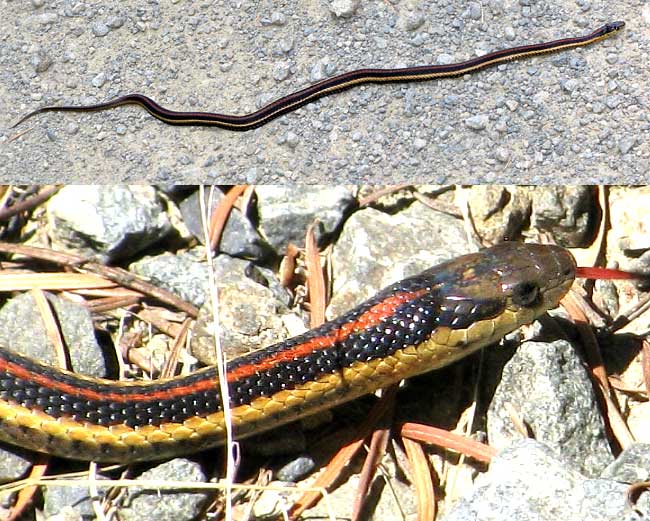Excerpts from Jim Conrad's
Naturalist Newsletter

from the August 30, 2009 Newsletter, issued from the Siskiyou Mountains west of Grants Pass, Oregon:
A REALLY PRETTY GARTER SNAKE
Above you see the garter snake I ran across this week as I descended along Shan Creek, coming down from Onion Mountain. I'd never seen a garter snake with such a nice red stripe down his back and at first I assumed it was a local race of the Common Garter Snake because some races of that species display red side stripes and red speckles. But my field guide didn't mention any race with a red stripe down its back.
The field guide cued me to be careful with this ID because in this part of Oregon we have four garter-snake species -- four species of the genus Thamnophis. None illustrated in my guide bore that red stripe. In the end I shipped the above picture to Dr. Tom Titus at the University of Oregonl.
Dr. Titus promptly replied: "This is a Northwestern garter snake (and one of the prettier ones I've seen, I might add). It looks as though it might have 8 upper lip scales rather than the typical 7, but the narrow head makes it T. ordinoides."
So, Northwestern Garter Snake, THAMNOPHIS ORDINOIDES, distributed from southwestern British Columbia south through here to extreme northwestern California. If I'd been able to catch him I might have been able to distinguish him from a Common Garter Snake because Commons typically area covered with 19 rows of scales while Norhwesterns bear only 17.
While learning more about this species by browsing the Internet I read that gartersnakes, which we usually think of as completely harmless to humans, have toxins in their saliva which can be deadly to their prey. Their bite might even produce an unpleasant reaction in humans, though they are by no means t dangerous to us.
At the excellent California Reptiles & Amphibians site at http://www.californiaherps.com I also read about studies showing that the escape behavior of Northwestern Garter Snakes, which are highly variable in their appearance, is determined by pattern: Striped snakes tend to escape by crawling away, maybe because the stripes make it difficult to determine the snake's speed. Spotted or plain individuals, however, crawl, suddenly change direction, then hold still, possibly because their irregular pattern blends in with the background.